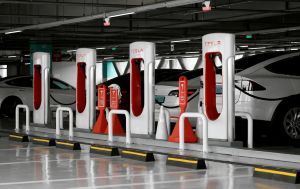Introduction
LiCB Charge, a leading EV chargers manufacturer in China, delivers reliable AC and DC electric vehicle charging stations along with comprehensive charging solutions.
As urban areas expand and building codes evolve, municipalities continue to mandate a minimum number of parking spaces for residential, commercial, and public developments. While this ensures accessibility for drivers, a major shift is transforming the parking landscape: the rapid rise of electric vehicles (EVs).
Today’s EV drivers aren’t just looking for a place to park—they expect the ability to charge while they do so. For parking lot operators, this presents a timely opportunity to stay ahead of the curve. By integrating EV charging stations into their facilities, operators can attract new customers, increase revenue, improve space utilization, and future-proof their operations.
Electric mobility is not a fleeting trend. It’s a global transformation. Governments worldwide are setting aggressive targets for EV adoption and phasing out internal combustion engine (ICE) vehicles. Parking lots that embrace this change now will be best positioned for long-term success.
This article explores the advantages of EV charging for parking lots, key installation guidelines, and how different property types can adapt their infrastructure to serve a new generation of drivers.
Benefits of Installing EV Charging Stations in Parking Lots
1. Attract and Retain New Customers
Adding EV chargers can immediately increase a lot’s visibility and appeal. As the EV population grows, so does the demand for charging-enabled parking. Many EV drivers actively seek out such locations—and once they find one, they tend to return.
Whether it’s a shopping mall, office park, or medical center, offering EV charging:
- Draws in eco-conscious and tech-savvy drivers
- Encourages longer visits and repeat usage
- Enhances customer satisfaction by easing "range anxiety"
Businesses that provide reliable charging build loyalty and set themselves apart from competitors that don’t.
2. Generate Additional Revenue
EV charging stations create direct and indirect revenue streams.
Direct Income:
- Charge per session, per hour, or per kWh
- Offer premium fast-charging options at higher rates
- Implement tiered pricing for different customer types (public, tenants, employees)
Indirect Income:
- Increased foot traffic = more retail and restaurant sales
- Cross-promotions with on-site businesses or nearby vendors
You can also explore partnerships with EV manufacturers or charging network operators to offset installation costs or share ongoing revenue.
3. Increase Occupancy Rates
EV-equipped parking lots are more attractive to a wider range of users. As EV adoption rises, so will demand for charging spots—especially in high-traffic locations.
Facilities like:
- Universities
- Office complexes
- Healthcare campuses
…often host vehicles for extended hours. In these settings, even slower Level 1 or Level 2 chargers are highly practical.
Greater utilization means higher revenues and better use of your existing real estate.
4. Diversify Your Services
EV charging adds a new layer of services to traditional parking.
Options include:
- Smart charging: Mobile app control, remote monitoring, usage analytics
- Reservation systems: Drivers can book a charger in advance
- Valet charging: Staff plug in and unplug customer vehicles
- Loyalty incentives: Discounts, bonus charging minutes, or rewards
You can even collaborate with local businesses (e.g., offer coffee shop discounts during a charge session) to create unique experiences that drive customer engagement.
5. Future-Proof Your Business
Electric vehicles are the future—policy, innovation, and consumer demand all point in that direction.
Countries and states are moving quickly:
- European Union plans to ban new ICE vehicle sales by 2035
- California and New York have set similar targets
Installing EV infrastructure today ensures:
- Long-term relevance in a changing market
- Higher property value and appeal to tenants
- A reputation for sustainability and innovation
Guidelines for Installing EV Charging Stations by Property Type
Office Parks, Campuses, and Medical Centers
- Recommended Charger Types: Level 1 or Level 2
- Suggested Ratio: 1 charger for every 10–20 spaces
- Best Practices:
- Survey employees or tenants to estimate demand
- Provide signage and wayfinding to chargers
- Include smart charging management for energy optimization
Apartments, Condos, and Multi-Family Housing
- Charger Type: Level 1 for overnight use; Level 2 for faster access
- Charger Density: 1 per 10–20 units or shared access in common areas
- Considerations:
- Offer assigned spots with charging access
- Explore metered usage or billing integration with tenant utilities
- Ensure future scalability
Industrial Parks and Commercial Facilities
- Dual Needs:
- Employee Vehicles: Level 1 or Level 2
- Fleet/Delivery Vehicles: DC Fast Chargers or commercial-grade EVSE
- Planning Tips:
- Separate employee and fleet charging zones
- Analyze load requirements for heavy-duty vehicle charging
- Coordinate with energy providers for long-term expansion
Conclusion: The Future of Parking is Electric
EV charging stations are quickly becoming a standard expectation, not an added luxury. Parking lot operators who move early will not only meet rising customer demand but also secure a competitive advantage that drives long-term success.
By integrating EV charging now, you can:
- Attract more customers
- Enhance loyalty and satisfaction
- Boost revenue through both direct charging fees and increased foot traffic
- Increase occupancy and space utilization
- Stay ahead of government mandates and consumer trends
As the mobility landscape shifts, so must your business. The infrastructure decisions you make today will determine your relevance tomorrow. EV charging isn’t just a service—it’s a strategic investment in the future of urban transportation. Know more about Google SEO Directory





Comments